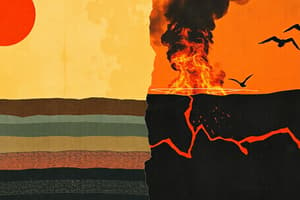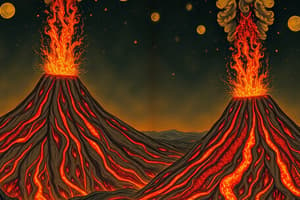Podcast
Questions and Answers
A region experiences frequent earthquakes along a transform plate boundary. Which type of fault is MOST likely to be the primary source of these earthquakes?
A region experiences frequent earthquakes along a transform plate boundary. Which type of fault is MOST likely to be the primary source of these earthquakes?
- Strike-slip fault (correct)
- Reverse fault
- Thrust fault
- Normal fault
During an earthquake, a person attempts to run outside. Why is this course of action considered unsafe?
During an earthquake, a person attempts to run outside. Why is this course of action considered unsafe?
- Falling debris poses a significant threat. (correct)
- There is a higher risk of encountering sinkholes.
- Open spaces lack sturdy objects for cover.
- The ground is more unstable outdoors.
An earthquake occurs offshore, triggering a tsunami. Several hours later, a series of devastating waves inundate a coastal city hundreds of kilometers away. What action could have provided the MOST immediate warning to residents before the tsunami's arrival?
An earthquake occurs offshore, triggering a tsunami. Several hours later, a series of devastating waves inundate a coastal city hundreds of kilometers away. What action could have provided the MOST immediate warning to residents before the tsunami's arrival?
- Tracking changes in atmospheric pressure.
- Observing a sudden drop in sea level. (correct)
- Listening for unusual animal behavior.
- Monitoring tide gauge anomalies.
A coastal town is located near a subduction zone. What combination of geological events poses the GREATEST tsunami risk to this town?
A coastal town is located near a subduction zone. What combination of geological events poses the GREATEST tsunami risk to this town?
After a significant earthquake near the coast, official warnings for a potential tsunami are issued. What is the MOST appropriate course of action for people living in low-lying coastal areas?
After a significant earthquake near the coast, official warnings for a potential tsunami are issued. What is the MOST appropriate course of action for people living in low-lying coastal areas?
How does volcanic ash contribute to short-term climate change following a major eruption?
How does volcanic ash contribute to short-term climate change following a major eruption?
In a subduction zone where an oceanic plate collides with a continental plate, which plate typically subducts and why?
In a subduction zone where an oceanic plate collides with a continental plate, which plate typically subducts and why?
If seismograph stations A, B, and C record an earthquake, what process is used to determine the earthquake's epicenter?
If seismograph stations A, B, and C record an earthquake, what process is used to determine the earthquake's epicenter?
How does the movement of the hanging wall relative to the footwall differentiate a normal fault from a reverse fault?
How does the movement of the hanging wall relative to the footwall differentiate a normal fault from a reverse fault?
Consider two earthquakes: one with a magnitude of 6.0 and another with a magnitude of 8.0. Approximately how much more powerful is the magnitude 8.0 earthquake compared to the magnitude 6.0 earthquake?
Consider two earthquakes: one with a magnitude of 6.0 and another with a magnitude of 8.0. Approximately how much more powerful is the magnitude 8.0 earthquake compared to the magnitude 6.0 earthquake?
Flashcards
Magma
Magma
Molten rock beneath the Earth's surface.
Lava
Lava
Molten rock that has erupted onto the Earth's surface.
Ring of Fire
Ring of Fire
A major earthquake and volcano zone around the Pacific Ocean.
Subduction Zone
Subduction Zone
Signup and view all the flashcards
Seismograph
Seismograph
Signup and view all the flashcards
Strike-Slip Fault
Strike-Slip Fault
Signup and view all the flashcards
Fault Type Determinant
Fault Type Determinant
Signup and view all the flashcards
Earthquake Safety
Earthquake Safety
Signup and view all the flashcards
Tsunami Definition
Tsunami Definition
Signup and view all the flashcards
Tsunami Action
Tsunami Action
Signup and view all the flashcards
Study Notes
- Magma is molten rock beneath the Earth's surface, while lava is magma that erupts onto the surface.
Volcanic Ash & Climate Change
- Volcanic ash in the atmosphere blocks sunlight, leading to a cooling effect on the climate.
- Volcanoes release gases like CO2 and SO2 that impact atmospheric temperature.
Active Volcanoes
- Alaska has the highest number of active volcanoes in the United States.
- Kīlauea in Hawai'i has been erupting for almost 40 years.
Ring of Fire
- The Ring of Fire is a major area in the Pacific Ocean basin with frequent earthquakes and volcanic activity.
- This zone is located along tectonic plate boundaries.
Subduction Zones
- A subduction zone is where one tectonic plate slides beneath another.
- Volcanoes form at subduction zones because the subducting plate melts, magma rises, and forms volcanoes.
- At subduction zones, an oceanic plate typically subducts under a continental plate due to differences in density.
Types of Volcanoes
- The four major types of volcanoes are shield, cinder cone, composite (stratovolcano), and lava dome.
- Shield volcanoes are large and rounded, exemplified by Mauna Loa in Hawaii.
- Mount St. Helens is classified as a composite volcano (stratovolcano).
Seismic Waves
- Seismic waves are energy waves caused by earthquakes.
- Earthquake wave strength is measured by magnitude.
- Higher magnitude values indicate significantly more destructive earthquakes; for example, magnitude 9 is much more destructive than magnitude 1.
- A seismograph (seismometer) is used to measure earthquake magnitude.
Earthquake Epicenter
- The epicenter is the point on Earth's surface directly above the earthquake's focus.
- Locating an epicenter requires data from three seismograph stations, using the triangulation method.
Faults
- A fault is a break in the Earth's crust where movement occurs.
- The three main fault types are normal, reverse, and strike-slip.
- A normal fault involves the hanging wall moving down relative to the footwall.
- A reverse fault involves the hanging wall moving up relative to the footwall.
- A strike-slip fault involves plates sliding past each other horizontally.
- Tensional, compressional, and shear stresses on rocks determine the fault type.
Earthquake Safety
- "Drop, Cover, and Hold On" under sturdy furniture is the recommended safety measure during an earthquake.
- Running outside is dangerous during an earthquake due to the risk of falling debris.
Tsunamis
- A tsunami is a large sea wave caused by underwater disturbances.
- Tsunamis can be caused by earthquakes, underwater landslides, and volcanic eruptions.
- Tsunami damage includes flooding, destruction of buildings, and loss of life.
- Warning signs of a tsunami are rapid ocean withdrawal and a strong earthquake near the coast.
- If caught in a tsunami, immediately move to higher ground and stay away from the coast until official warnings are lifted.
Studying That Suits You
Use AI to generate personalized quizzes and flashcards to suit your learning preferences.




